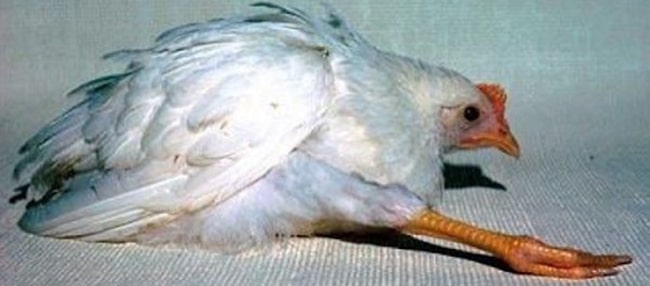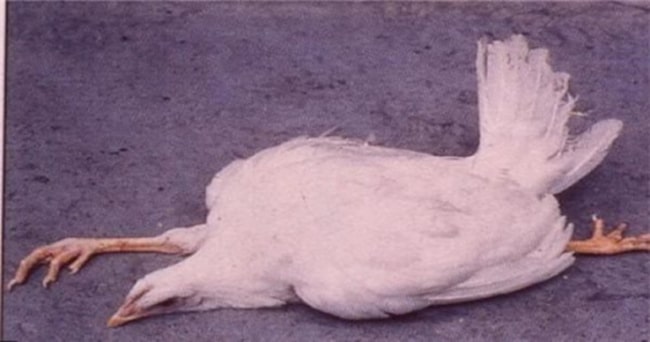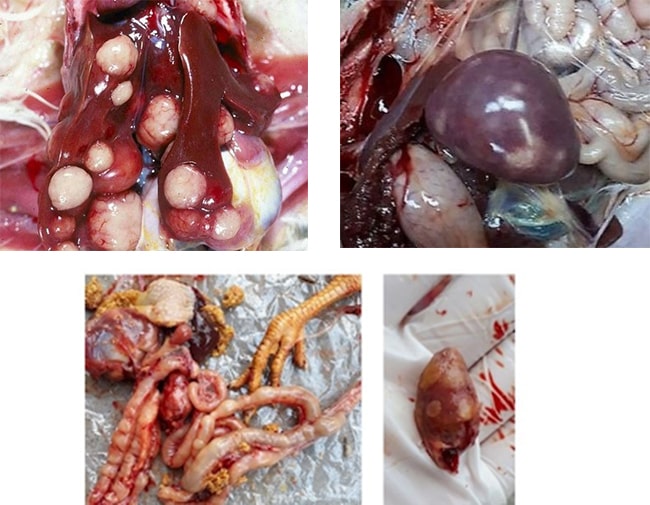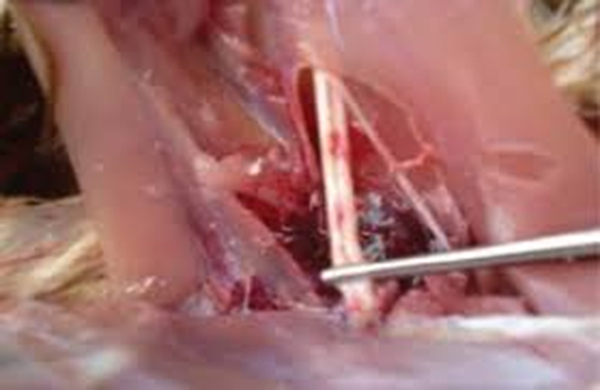Marek's disease in chickens, also known as avian cancer, chicken paralysis, or tumor syndrome, is a viral disease that has no known cure. Chickens infected with Marek's disease have a high mortality rate, reaching up to 60-70%. The disease causes stunted growth, emaciation, reduced egg production, and poor hatchability in affected flocks. What makes this disease particularly dangerous is that the virus persists in the chicken's body, serving as a source of infection and leading to significant economic losses.
Therefore, the identification and effective prevention of Marek's disease are of utmost importance. Please continue reading the following article to gain a better understanding of this disease.
The cause of Marek's disease in chickens
The cause of Marek's disease in chickens is the Herpesvirus of the genus Mardivirus, specifically Herpesvirus type B. It is an enveloped RNA virus and is currently classified into three serotypes:
- Serotype 1: These strains are oncogenic and highly virulent, causing tumor formation in infected chickens.
- Serotype 2: These strains do not induce tumor formation and are generally considered non-oncogenic.
- Serotype 3: These strains have low virulence and do not cause disease. They are primarily found in turkeys and are commonly used as vaccine strains against Marek's disease.
It's important to note that Marek's disease is primarily caused by serotype 1 strains, which are highly pathogenic and responsible for the majority of clinical cases in chickens.
- Marek's disease affects chickens of all ages, but it particularly affects chickens over 6 weeks old, with the majority of cases occurring between 8-12 weeks of age.
- The disease spreads rapidly within a flock, and the infection rate can range from 10% to 60%. The mortality rate is high, typically ranging from 60% to 70%, but in severe cases, it can reach 100%.
- One of the characteristics of Marek's disease is the high proliferation of lymphoid cells in the form of tumors in the peripheral nervous system, internal organs, skin, and muscles. This abnormal cell growth leads to the development of symptoms such as motor disorders and paralysis.
- Marek's disease is transmitted directly from sick chickens to healthy chickens through the digestive and respiratory routes. Marek's disease can also be indirectly transmitted through contaminated food, water, farming equipment, or hatcheries that harbor the disease-causing agents.
- Marek's disease is not transmitted through the embryo.
The symptoms of Marek's disease.
Acute form:
Commonly seen in chickens aged 4-8 weeks, this disease has few typical symptoms.
Chickens may die suddenly, with a mortality rate of 20-30%. They often appear lethargic and emaciated before death.
Affected chickens exhibit reduced appetite, difficulty in movement, paralysis, wing drooping on one side due to inflammation of the motor nerves, decreased egg production, and watery droppings.
Chronic form:
Commonly seen in chickens aged 4-8 months, this disease has two forms: neurological form and ocular form.
Neurological form: Affected chickens have difficulty in movement, paralysis of the legs and wings. In the early stages, wing drooping may be observed, and the hind legs may exhibit unsteady movement, with the three toes clumped together. As the condition progresses, the chicken becomes completely paralyzed.
Ocular form: Chickens experience inflammation of the eyes, reduced reflexes, and in severe cases, it can lead to blindness.
In addition, chickens may also experience respiratory difficulties.

Image 1: Paralyzed Chicken

Image 2: On the left (normal eye), on the right (diseased eye)
The consequences of marek’s disease
The deceased chicken has a dry and emaciated carcass. The typical posture of a dead chicken includes one leg stretched straight forward and the other leg stretched backward, with the sole of the foot facing upward.

Image 3: Chicken death pose
The appearance of distinct grayish-white tumors can be observed on internal organs such as the liver, heart, lungs, and spleen. These tumors consistently exhibit clearly defined borders.

Image 4: Tumors appearing in internal organs such as the liver, spleen, intestines, and heart.
The liver and spleen are enlarged compared to normal, pale in color, and prone to rupture.
Inflammation and increased proliferation of peripheral nerves.

Image 5: Nerves are swollen and bigger than normal.
Muscles experiencing atrophy, blindness in the eyes, and deformation of the pupils.
To effectively prevent marek's disease
Marek's disease is caused by a virus, there is no specific treatment. Therefore, it is necessary to implement effective disease prevention measures.
When there is no disease:
- Vaccinating the chickens at one day old with the recommended dosage of the Marek's disease vaccine
- Ensuring an adequate supply of water and feed for the poultry flock, as well as maintaining appropriate stocking density according to the age of the chickens
- Regularly disinfect the farm barn 1-2 times per week using POVIDINE-10% at a dosage of 10ml per 3 liters of water.
- Additionally, sprinkle LIVESTOCK BEDDING (PROBIOTIC BEDDING FOR LIVESTOCK) on the floor of the breeding area to reduce toxicity, eliminate odors, and control the growth of bacteria.
- For large-scale poultry farms, it is necessary to have separate areas for chicks, broilers, layers, and breeders, strictly adhering to the rule of "all in, all out." After removing the birds from the barn, both the interior and exterior of the barn should be thoroughly cleaned using G-OMNICIDE at a dosage of 2-3ml per 1 liter of water. It is also important to allow a minimum of 1 month for the barn to remain empty.
When a disease occurs.
- Diseases need to be detected early for appropriate intervention measures.
- Destroy the entire flock of infected chickens, without transporting infected chickens outside, while also handling residual waste (feces, garbage, etc.).
- For the poultry flock infected with the disease, the barn should be left empty for at least 3 months and regularly disinfected using G-ALDEKOL DES FF at a dosage of 5ml/1 liter of water.
- Especially, do not bring in new chickens for farming during the period of handling the diseased flock.
Above information are the effective Marek's disease prevention measures that Goovet would like to share. Wishing success to all livestock farmers!
